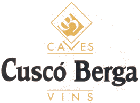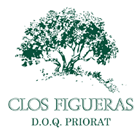Cava Varias
by
Kathy and Terry Sullivan
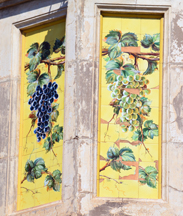 The Cava Varias winery stands tall in Sant Sadurní d’Anoia, a town now recognized as the capital of cava. The shape of the building is quadrilateral, and is three stories tall with church-like windows lining the length of the second floor. The sign for Miró is easy to see at the very top of the winery. The top of the building continues to bear the name of the original winery XAMPANY NOVA and J. MIRO set in ceramic tiles on a bright yellow background. Other ceramic tiles show grape bunches.
The Cava Varias winery stands tall in Sant Sadurní d’Anoia, a town now recognized as the capital of cava. The shape of the building is quadrilateral, and is three stories tall with church-like windows lining the length of the second floor. The sign for Miró is easy to see at the very top of the winery. The top of the building continues to bear the name of the original winery XAMPANY NOVA and J. MIRO set in ceramic tiles on a bright yellow background. Other ceramic tiles show grape bunches.
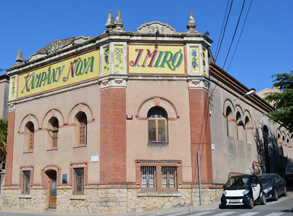 The original winery was founded by the Miró family who lived in Sant Sadurni d'Anoia. The building was built and designed in 1918 by Cèsar Martinell, a Gaudí disciple, who was a modernist who designed cathedral-style wineries. These types of winery buildings are no longer built because they are too expensive.
The original winery was founded by the Miró family who lived in Sant Sadurni d'Anoia. The building was built and designed in 1918 by Cèsar Martinell, a Gaudí disciple, who was a modernist who designed cathedral-style wineries. These types of winery buildings are no longer built because they are too expensive.
When the Miro family did not want to continue in the wine business, the winery was sold to Pere Varias in 2003. Pere was interested in purchasing the company because he had worked in the cava industry since he was 14 years old and worked in the cellars. Pere purchased the bodega as a new career. He now works for himself. Today his son, also named Pere, runs the company and the second generation has not made many changes in the winery. Cavas continue to be produced the same way, although there is a combination of tradition with modernization. Since the building has not physically changed, it was necessary for the traditional ways of producing cava to continue.
Pere explained that he has three business. He has vineyards and these vineyards sell grapes to a cellar that makes the base wines. The winery owns 20 hectares (49 acres) of vineyards including the varietal grape Xarel.lo. Grapes like Macabeo and Parellada are purchased from other growers. The production facility is a second business and the winemaker selects the coupage for the cavas and still wines. The third business is this aging and bottling facility.
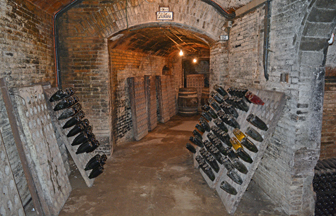 We toured the cellars with Pere Varias and Maria Mata, export manager. The flight of stairs down to the cellar had a warm glow as soft light reflected off the terra cotta ceiling. At the base of a turn the word “Varias” was prominent as was a display of a vine now used to hold two cava bottles. We meandered through the tunnels. Chambers off the pathway were filled with cava bottles. We noticed signs with names at the entrance of some chambers. These signs were the names of family members. In one passageway, riddling racks leaned against the wall. Some of these racks had bottles in them.
We toured the cellars with Pere Varias and Maria Mata, export manager. The flight of stairs down to the cellar had a warm glow as soft light reflected off the terra cotta ceiling. At the base of a turn the word “Varias” was prominent as was a display of a vine now used to hold two cava bottles. We meandered through the tunnels. Chambers off the pathway were filled with cava bottles. We noticed signs with names at the entrance of some chambers. These signs were the names of family members. In one passageway, riddling racks leaned against the wall. Some of these racks had bottles in them.
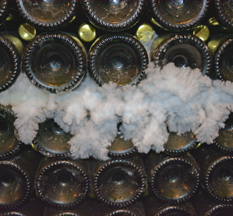 The walls of the cellars are lightly colored aged brick. After passing the old cement vats in the cool, damp cellars, visitors will eventually notice a bright, white substance on and adjacent to some of the cava bottles. Curious tourists will discover that this is called cava mold. The fungus forms because of the dampness of the cellar. Some of the patterns of mold look like they were painted by an artist. While walking in the cellars, visitors can view a small display of aged, dusty cava bottles with very deep punts. These bottles were left by the original owners of the winery.
The walls of the cellars are lightly colored aged brick. After passing the old cement vats in the cool, damp cellars, visitors will eventually notice a bright, white substance on and adjacent to some of the cava bottles. Curious tourists will discover that this is called cava mold. The fungus forms because of the dampness of the cellar. Some of the patterns of mold look like they were painted by an artist. While walking in the cellars, visitors can view a small display of aged, dusty cava bottles with very deep punts. These bottles were left by the original owners of the winery.
The largest section of the building is a warehouse on the ground floor level. Boxes of cava and wine line the perimeter. Behind the cases of cava, there is a beautiful blue pattern ceramic covering on the bottom of the wall to a meter in height. The ceiling in this part of the structure resembles a church ceiling reinforced with modern steel.
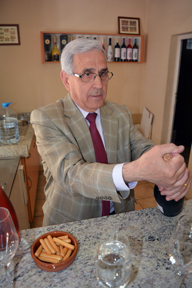 Cavas
Cavas
Our cava tasting took place in a room at the entrance of the front of the building. Adjacent to the tasting counter area is the office workplace for Cava Varias. This area is separated by riddling racks.
The Al·legoria Brut Nature Reserva was a blend of Macabeo, Xarel.lo, Parellada and a splash of Chardonnay. It was aged for 24 months and disgorged just three weeks prior to our tasting. The cava was a pale yellow color and offered pear, apple, some mineral and a hint of freshly baked bread on the aroma and taste. The cava had a very fine bead of bubbles rising to the surface to form a mousse.
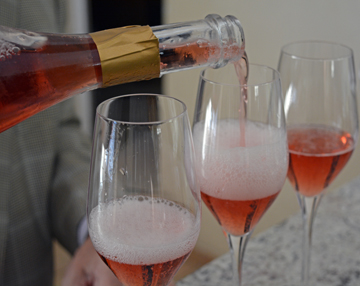 The Special Rosé Reserva Brut Nature was made entirely of Pinot Noir. The cava was a light red color with an orange hue. Multiple columns of beads rose to the top forming a mousse in the center and along the circumference. Strawberry was predominant on the aroma and taste. The mouthfeel was lively and there was a hint of salt on the finish.
The Special Rosé Reserva Brut Nature was made entirely of Pinot Noir. The cava was a light red color with an orange hue. Multiple columns of beads rose to the top forming a mousse in the center and along the circumference. Strawberry was predominant on the aroma and taste. The mouthfeel was lively and there was a hint of salt on the finish.
Wine Tourism
Organized tours at Cava Varias are available by appointment for up to 15 people.
Cava Varias
Pl. Manuel Raventós 8
08770 Sant Sadurní d’anoia
(Barcelona), Spain
Article written June 2015
Please support the following.
 |
|||
 |
 |

